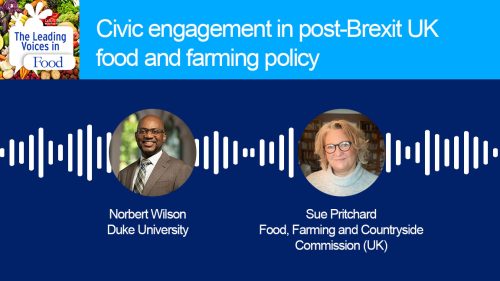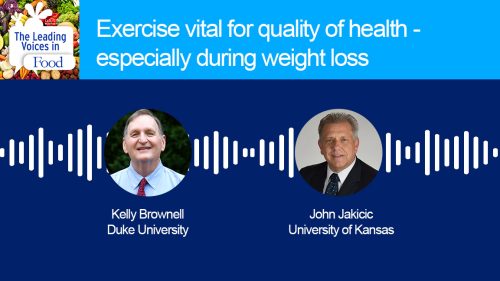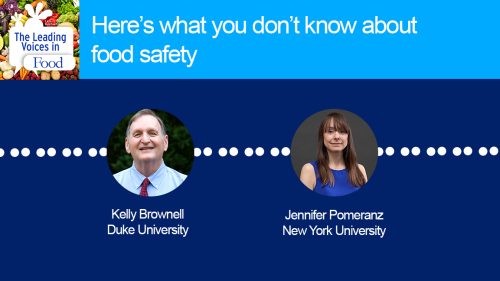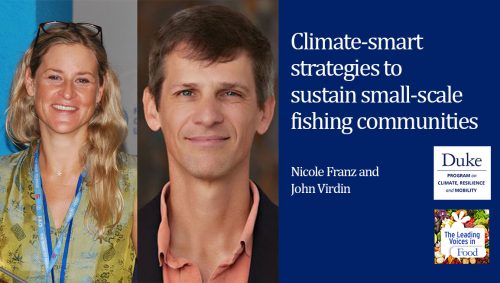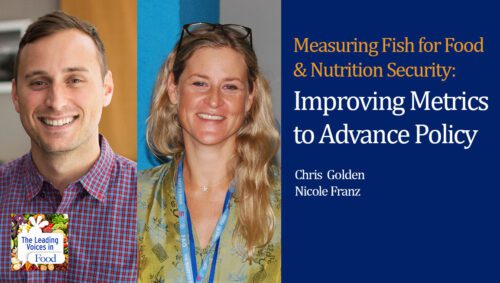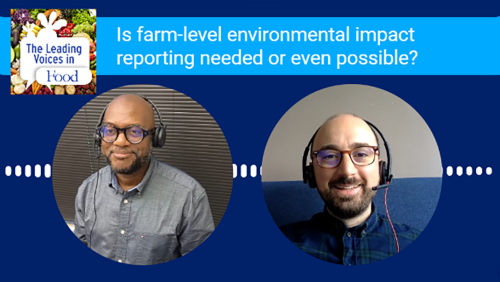The Leading Voices in Food
E255: Reducing food waste: Less seafood wasted than thought in US
The U. S. is the largest importer of aquatic foods, which includes fresh and saltwater fish, crustaceans, mollusks, and aquatic plants served in restaurants and homes. A critical piece of this global market is the cold chain, keeping these foods chilled or frozen during storage and transport to market. With 44 percent of aquatic foods sold live or fresh globally, the percentage of fresh over frozen aquatic foods creates an extra logistical cold chain challenge. What’s more, most aquatic foods become, well, fishy from cold chain disruptions, which can cause perceived food safety concerns, potentially resulting in food getting tossed into the bin. Until recently, research to understand just how much aquatic food gets wasted or lost has been spotty. However, in a recent Nature Food article, researchers argue that aquatic food loss and waste in the United States is actually half of earlier estimates. And that’s good news that we’ll explore today. This interview is part of an ongoing exploration of food loss and waste.
Subscribe: Apple Podcasts | TuneIN | YouTube Music | SoundCloud | PocketCasts | Radio Public
Tags: Agriculture & Tech | Climate Change, Environment & Food | Diet & Nutrition | Fisheries & Food Policy | Food Safety & Food Defense |

Dave Love is a Research Professor at the Johns Hopkins Center for a Livable Future. Dave’s work focuses on aquaculture and fisheries and the environmental, social, health and food system issues related to those industries. He also engages in a wide range of food-related topics including food waste, veterinary drugs and drug residues in foods, antimicrobial resistance, and CAFO worker and community health. In 2012 he founded a research and teaching farm at the Cylburn Arboretum in Baltimore and oversaw the facility from 2012 to 2015. The farm is now called the Food System Lab and is a place where students of all ages learn about urban agriculture. The Food System Lab is a member of the Farm Alliance of Baltimore and sells produce at the Waverly Farmers Market. Prior to joining Johns Hopkins Dave was a postdoctoral fellow with Dr. Kara Nelson, working at the interface of engineering and microbiology, in the Department of Civil and Environmental Engineering at the University of California Berkeley.
Frank Asche is a professor of natural resource economics at the University of Florida School of Forest, Fisheries, and Geomatic Sciences. He is a natural resource economist with a research focus on seafood markets, production of seafood from fisheries and aquaculture and the sustainability of these production processes. Frank is president of the International Association of Aquaculture Economics and Management (IAAEM), editor for Aquaculture Economics and Management and associate editor for Marine Resource Economics. He was also a member of the team that developed the Fish Price Index of the United Nation’s Food and Agricultural Organization (FAO).
This podcast is co-sponsored by the Recipes Food Waste Research Network Project, led by American University and funded by the National Science Foundation.
Interview Summary
Martin Smith – So I’m really pleased to introduce our guests for today. First up from University of Florida, a natural resource economist, Frank Asche. Frank is a long-time collaborator of mine and a good friend. And he’s also one of the world’s leading experts in seafood markets and trade. And honestly, Frank has taught me just about everything I know about aquaculture.
Also today, we have Dave Love from the Johns Hopkins Center for a Livable Future. Dave is someone whose work I’m also very familiar with and is a leading expert in food systems and sustainability. And recently in my classes, I have often said out loud to some student questions that I don’t know the answers to. I’ll bet Dave Love knows the answer to that question.
Norbert Wilson – So Dave, let’s begin with you. Why was it important to develop better estimates and methods of aquatic food waste in the US? Why did your team pursue this research question?
Dave Love – Great question. So, the US government has a goal of cutting food waste in half by 2030. And if you want to know how much you need to cut, you really need to go out and measure. And that’s one of the areas of food waste that we really don’t know a lot about for many different types of foods. We know the production data. We know how much is produced. We have a pretty good sense of what’s consumed, whether that’s in an economic sense of being consumed or actually eaten. But we really don’t know how much is wasted. And groups come to the table with different numbers, different estimates, and they, they make their way into reports, into national guidelines. But for seafood in particular, the estimates haven’t been refreshed in a while. So, it was about time to do that. And this study aimed to tackle that issue from all the stages of the supply chain, from production to consumption, looked at different forms of seafood and among the top 10 species. So, we rolled those species estimates and stage estimates into a national number. So yeah, that that’s, that’s why we did it. And we were really surprised at what we found.
Norbert – Well, what surprised you?
Dave – Well, earlier estimates were that about half of seafood was lost or wasted in the US and that came from UN Food and Agriculture Organization data. And when we actually crunched the numbers for the US supply, we thought it was more like 22.7 percent is wasted. So, a lot less than the FAO estimate. Which means we’re doing a good job in some areas, but there’s also room for improvement in others.
Martin – So, Frank, maybe you could tell us a little bit more about the key takeaways from this Nature food paper are?
Frank Asche – It’s really that it’s important to recognize that we are consuming a lot of different species and they have very, very different characteristics. For instance, the filler yield of a salmon is about 65 percent while for a cod it is about 40%. That makes your starting point really important. Moreover, this thing of looking at the whole supply chain is important because there are different ways to organize it, and there are a lot of potential uses for what food is sometimes wasted. And to look into what different types of producers are actually doing. What different companies that are operating these cold chains that Norbert spoke about are doing. And what they are doing when these things break apart. Kind of, there’s all these people in the supply chain that may help us, and some of them do. Some of them aren’t very good at it. But it’s really nice to find that there are best practices that can really help us a lot of people take the trouble to figure that out and follow that up.
Martin – That’s really interesting. And it makes me wonder with all this heterogeneity that you’re describing, are large producers better positioned to manage or, or reduce food waste than small producers? Or is it the other way around?
Frank – Oh, I’m a good researcher. So it depends.
Martin – It depends. Of course it depends. It depends!
Frank – If we’re going to say anything general then, in wealthy countries, large producers are better. In poor countries, small producers are better. In the sense that when labor cost is low, and food is relatively expensive people are much more willing to eat a fish that is not the best quality. While, if you’re a small-scale producer in a wealthy country where labor is really scarce, you tend to focus on your main production process, which is the fillet. While if you become a big producer, then the quantities that potentially gets weighed that become so large that they actually are a useful raw material for new products. And we see big producers developing new products that it doesn’t make sense for smaller producers to look at.
You’ve all eaten your hamburgers. One of the more popular products in recent years is different kinds of seafood burgers. And they are great because they are trimmings and cutoffs and slices that doesn’t fit well into that fillet that you’re normally thinking about when you’re consuming a chunk of fish.
Martin – Yeah, and I think many seafood consumers have had that experience of being at the fish counter and saying, ‘Oh, I only want this much,’ and they put too much in there and like take a little off. And then you start to ask yourself the question, who’s going to eat that little, little bit that gets sliced off. That’s really interesting and enlightening. I had another question for Frank. Before we go back over to Norbert. So, in this paper, you describe different points along the food supply chain where the seafood might be lost or wasted. Can you talk a little bit more about that in different points in the supply chain and why there are some of these differences between species? You mentioned the sort of, yield of salmon and cod for a filet being a little different. And so, I’d like you to talk a little more about why different species might, might get different rates of loss.
Frank – I think it starts with this thing here that for most seafood species, there’s a choice part that is sort of your preferred chunk of meat. Most species it’s a filet, but for a mussel, you eat everything that is within the shell. But it’s different. But even for all those species, kind of, there are shrimps with small heads, there are shrimps with big heads, there are fish that gives you really good fillet yield, fish that doesn’t. There are fish where there’s a lot of useful meat that, say, the head or in the tail, that normally doesn’t make it to a store, but it’s useful if somebody chooses to use it. And then you have the quality issues. If a fish, say, falls to the floor during the production process, what do you do with that? And, yeah, that’s one of those things we learned that in Vietnam, they will give it to a worker, and they will eat it. And Norwegian salmon, they will typically put it into some kind of acid where they use it to make animal foods. Small scale producers will just throw it into the bin. Other producers have good systems which, within the right hygienic control systems, are using what they can and not what they cannot. In general, producers have been getting better, but producers are still one of the key points in the chain. The companies from the producer of the raw fish to the consumer is generally pretty good. And there’s fairly little waste in transportation and processing and so on. Then there’s a bit more waste in the store. One of the cool little episodes I learned during this project was that one of the biggest items of food loss for fish in US grocery stores were people buying shrimp for the salad, and then deciding that they didn’t want the salad anyway, and they are putting it in a shelf somewhere else.
But you and I are the biggest problems. That is, what do we do with what we do not eat when we come home? What do we do with this portion that we put out of the freezer, and we didn’t eat all of it. And we are pretty bad when we go to a restaurant too. And too often we don’t eat our full portion. We may wrap it, but, but do we actually eat it the next day? In general, we do not.
Norbert – Dave, I have a question. I recognize you as a sustainability expert. So how does understanding the pinch points for aquatic food losses and waste help households, the food industry and, and policymakers?
Dave – Seafood is one of the most expensive proteins. If you go to the grocery store, it’s going to be, you know, $9, $10 up to $15 or $20 a pound. And really, consumers don’t have that amount of money to throw out. If they’re going to buy it, it’s in their best interest to eat it. So, we’re looking at ways that the seafood industry can package and sell products that are going to help consumers, you know, stretch that dollar. One of the ways is through frozen seafood. Selling prepackaged individual units frozen. And, through this project, I’ve started to buy a lot more of that type of type of seafood. And you can also buy it now for other kinds of meats. And you just, whatever you want to prepare probably that, that next night you, you know, cut out the packaging, put it in the fridge and a little bowl in case from food safety standpoint in case it leaks. And then you don’t want to leave it on the counter overnight or leave it out for a couple hours.
But so, there are ways that you can package products that perceive what consumers are going to ask for. And you can still get that freshness in seafood, even if it’s frozen. Because a lot of frozen seafood is frozen on board the vessel. It’s frozen sooner than it actually would be if it was processed in a processing plant. So, you know, I think it’s kind of a win-win. We’ve been exploring cook from frozen as a not just food waste, but also for other angles of sustainability. Because of course when there’s waste is also the embodied energy and the embodied water and all the things that go into making that food. And when it gets to the consumer, it’s got a lot more of those steps involved.
Norbert – Thanks, Dave. I will say from some of my own research looking at package size, and package configuration that smaller, more readily used products are less likely to be wasted. I can appreciate that kind of innovation in seafood products could also be beneficial. And my family, we’re big users of frozen seafood, and the quality is good. So, these are really helpful ways of thinking about how we as consumers can make adjustments to our behavior that can actually mitigate some of the food waste that you all observed. And so, because of this research, what new insights do you have about loss along the supply chain for aquaculture versus wild capture fisheries?
Dave – That’s a really good question. I can speak to the production stage. That’s one of the areas we looked at where you see the most amount of food loss – at the production stage anyway. But we sort of split it out as the fisheries losses were either discards or bycatch. And from aquaculture, people had not really estimated what food loss looked like in aquaculture. But we looked at disease and mortality as a cause of food loss. We asked farmers, what’s your typical mortality rate when you’re raising shrimp or salmon or tilapia? We got back their mortality rate, we did some modeling, some estimation and found out when a certain percent of that harvest dies. Not just when they’re babies, but when they die close to the harvest period, we’d count that as, as food waste. Because there are ways to control disease in aquaculture. You know, it’s not going to be zero. There are always going to be some animals that die. But, if you do control disease, you can cut down on some of this kind of perceived food waste in the process. So, we counted those two things differently.
I would think a good example would be Alaska sockeye salmon. Over the last 10 or 15 years, they’ve instituted a lot of new methods for reducing damage to fish when they’re captured. For example, now you get incentives as a fisherman to put down rubber mats. So, when the fish come off nets, they don’t hit the boat hard, they’ll hit a rubber mat. Their incentive is to bleed the fish, which helps with quality. And of course, to ice them when they’re caught. You know, a lot of the catch of sockeye salmon in the ’80s – ’90s, didn’t necessarily get refrigerated after it was caught. It went to a canning line. And folks eating canned salmon, they couldn’t tell the difference. But as the salmon industry in Alaska transitioned to more of a value-based fishery, they increase the quality, increase the percentage of fillets compared to canned. I think a lot of these things go hand in hand with value. As you decrease food waste, increase food quality, you can sell it for more. I think that’s a nice transition point for a lot of farms and producers to think about.
Martin – Since we’re on salmon, I have a quick follow up on that. I noticed in the paper there is some differences in the rate of food waste for wild caught sockeye and for farmed Atlantic salmon. And in my mind, I immediately went to, well is that because most of that wild caught sockeye is ending up frozen? Maybe it’s sold at the fresh counter, but it’s been previously frozen. That’s certainly my experience as a seafood consumer. And most of that farmed Atlantic salmon is actually sold directly as fresh and never frozen. And so, I’m wondering how much of that is a driver or how much it’s really the disease thing?
Dave – It’s probably a little bit of both. At the retail stage, if you’re going to a grocery store and you’re looking at that fresh display case, the rate of waste there is somewhere between five and 10 percent of what’s in that display case. It’s going to end up in the garbage. They want to just have a nice presentation, have a lot of different products laid out there and they don’t all get purchased. Some grocery stores will prepare that and sell it on a hot bar. Others, their principle is we just want to provide the freshest thing and they are okay with a little bit of waste. For canned and frozen seafood, the rate is more like 1%. And as Frank alluded to, sometimes people pick up a frozen item and they get to the checkout counter and they go, you know, I didn’t really want to buy that. And they might slip it into you know, another aisle where it shouldn’t be. That middle of the chain, there’s not a lot of waste that we saw. You know, wholesalers and distributors, that’s their job to deliver food and they really do a good job of it. And then at the upstream stage, the production stage, there’s a big range in waste. And it depends on the product forms and at what point is the fish cut and frozen.
Martin – So, I have a question for both of you now, maybe changing topics a little bit. So, reducing food waste, food loss and waste, is an important element of environmental sustainability. I think we all agree on that. And that’s particularly in response to climate change. We know that Greenhouse gas emissions associated with our food system are a major contributor to climate change. I’m wondering, sort of looking ahead, what role do you see seafood in general playing in a future in which we might price carbon emissions. We might actually make it costly to buy products that have a lot of that embodied greenhouse gas emissions in it.
Frank – Yeah, pretty well actually. But it depends a little bit on what’s your current diet. If it has lots of red meat, seafood is going to do really well because red meat in general have significantly higher carbon emissions. If you’re a vegetarian, maybe not that much. So, in the bigger scheme of things, seafood looks pretty good in the category of animal proteins, largely together with chicken. The difference between most seafoods and chicken is not too big. And of course, there’s a little bit of variation within the seafood. They of course have a problem though in that nature produces a limited quantity of them. And if the amount completely takes off, there’s no way you can increase the supply. So, then it must be aquaculture. And then you are more than slightly better or approximately chicken.
Dave – And I’d say you know, if you want to learn more about this topic, stay tuned. We’ve got a paper coming out about that. It should be out fall 2024 or early 2025. Similar to the waste piece, we’ve done the energy footprint, the greenhouse gas footprint, and the water footprint of all the products you see in the Nature Food paper. And we’re really excited to share this finding soon.
Martin – That sounds really exciting and I can’t wait to see it.
Norbert – I’m curious about your thoughts on how trade incentives or restrictions could be used to remote access to aquatic foods in addition to climate resilience of the food system? Frank, could you give us your thoughts?
Frank – Oh, there’s a short answer to that or a complicated answer. So, the short is, of course, you can do like you’re done with some other challenges. You also have dolphin-safe tuna and turtle-safe shrimp and so on. And you could basically make it hard to enter the market for people with bad practices. And you can make it easier to enter the market for producers with good practices. But if you go to the more complicated thingy, and particularly if you are also interacting with domestic supply chains, then we do know really well that eating beef is a real environmental challenge. But I still cannot see a world, at least within the foreseeable future, where US policy is going to sort of suggest that we’re going to import more seafood so that we can produce less beef. And when you get to all those complicated interactions, yes, you can use trade policies to advance some agendas. But they are certainly going to run into some others, and it’s a challenge when there’s so large heterogeneity when it comes to what do you think a good food system is.
Norbert – Dave, what about you?
Dave – Well, I sort of come at this from a different angle. You’re thinking about local; you know. What’s the value of local food and local and regional food systems? And so, in principle, I’d like to suggest that to people to buy their food from regional markets. Because of the connection to place and that’s really important. Once you have that connection to place, then you start to value the environment where it comes from. You get a little bit closer tied to the labor market and the folks who grow and produce that food. So, I like to kind of come at it from that perspective. Invariably we’re going to have some internationally traded seafood. Right now, 70 percent of seafood is imported. But I think looking at opportunities to support your local and regional fisheries, and your local and regional aquaculture, I think there’s a lot of merits to that. Some of them could be climate arguments. And there’s lots of other good arguments for it as well.
Frank – I agree with that, but I really think that you should have the caveat that producing your seafood, or really any food under good microclimatic conditions, with good soils or water for that product, gives you food with a much smaller footprint than what you have necessarily locally. And particularly if you’re producing something that doesn’t really belong that well locally. And it’s also really important that, except if you fly your food by air the carbon footprint of transports is tiny.
Dave – Yes, that was, that was one thing we found. With air cargo be really careful. You want to buy live seafood or fresh seafood that’s air freighted, that’s going to be a big piece of the carbon footprint. And really for consumers, an easy way to chip away at their environmental impact is to cut out stuff that’s flown in fresh. But, you know, that flies in the face of what restaurants and grocery stores are trying to sell, which is ‘the freshest.’ ‘We’re going to give you never frozen super fresh.’ So there’s a bit of a disconnect there. And I think unlocking that is going to be getting into some of these chefs’ minds and talking to them about – you know fresh is important, but how do you want to spin this in a way that you can have it fresh today, but you also can have it fresh in the future. Not just today, but a few generations down the road when it is possible to fly in food from all over the world that have that perfect plate. And you know, this is something that we need to engage with lots of different people on.
Martin – It sounds a little bit like you’re suggesting a, a world in which we, we seek to consume fresh local, and frozen global. In the sense that, that you cut down all those, those transportation, greenhouse gas emissions, if you’re doing frozen seafood, and you can exploit that sort of natural comparative advantages of different places to farm and different places to catch seafood with those global markets. But, but for the real fresh stuff, there might be some benefits to eating locally, including those, those greenhouse gas emissions.
Dave – When we looked at the trade from Asia, 99 percent comes by container ship. You know, almost nothing’s being flown in. And then when you look at closer markets to the US. What was Europe… it was maybe closer to 50 /50 for flown versus shipped by water. And yes, I think South America was similar. I guess the closer you get to the US market, you know, there’s that incentive to kind of fly it in and get the price premium. There’s definitely a reason to do it, but it does come with a part of the carbon footprint, you know. It’s, it’s maybe a quarter, maybe a third, you know?
Frank – But as Marty alluded to, as long as there’s no cost associated with the carbon footprint as is the case now, nobody will really care. It’s first when you actually have a system where there’s a price to it that you would expect to see any real change.
Dave – Yes. And, we did some work, sort of a spinoff to this. We looked at the US seafood industry and then they become more carbon neutral. We teased that out for a couple of different sectors: farmed catfish in Alabama and wild caught salmon. And there are steps that producers and fishers can do, but a lot of it’s going to have to depend on their local utility. What’s the energy mix of the utility? Because that utility energy mix is what feeds the plant. It feeds the energy going to a catfish farm. And they use a lot of electricity, but they don’t have a big say in what the Mississippi Electric Cooperative or Alabama Electric Cooperative chooses as its energy mix. So, I think there’s, it’s really a 360 issue that when you start trying to unpack energy and climate, it goes well beyond the seafood sector really quickly. So, we can be a voice. But it’s going to take a lot of people to make systematic change.
Martin – Great. So, I had one final question to ask each of you. And that’s really about what’s next? And I know we have this other paper that’s coming out to look deeply into the life cycle of the different species featured in your food waste paper. But I’m wondering specifically what’s next on seafood waste and, and what kinds of things will affect what kinds of policy changes might be on the horizon, what kinds of things will affect change, short of, I guess, what we’ve already talked about. Which is some, you know, sweeping carbon legislation that, that prices carbon. But short of that, what other kinds of things are going to affect change and what else do we need to know? Let’s start with you, Dave, and then then we’ll go to Frank.
Dave – I think we sort of laid out the big picture. The estimates for the US supply for different production stages. But I think we really need to drill down into case studies where folks, us and, and colleagues, I know Ronnie Neff is exploring this with you Norbert, but really drill down into case studies that try out some of these ideas that we have. Some of the innovations being implemented and see how they work and maybe scale up the best ones.
Frank – Right. And beyond that is like companies are doing what companies always have been done at all stages in supply chain. As long as new technology makes it profitable for them to be more sustainable, they’re going to be more sustainable. So, there’s going to be a lot of new packaging and new ways of chilling and so on that will help. But at the end of the day, the biggest challenge is you and I as consumers, and what we both buy. Because that determines what products is going to be on offer. And then how we treat them after we have purchased them.



